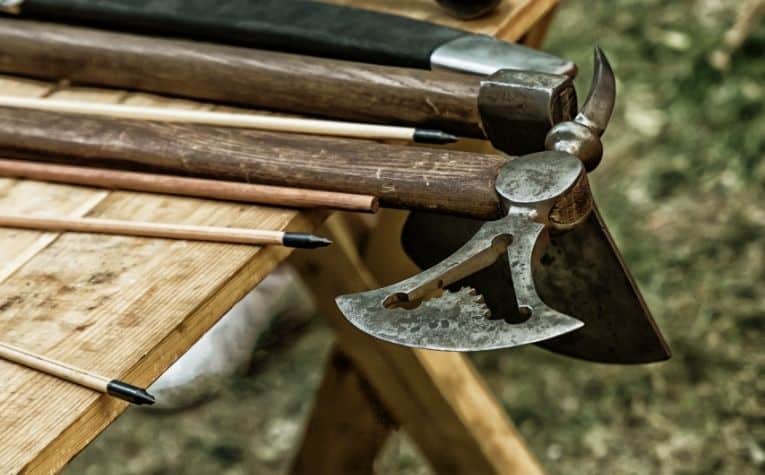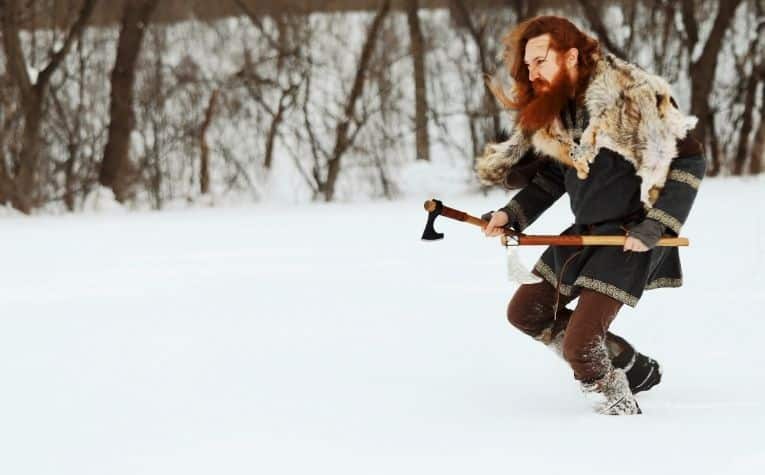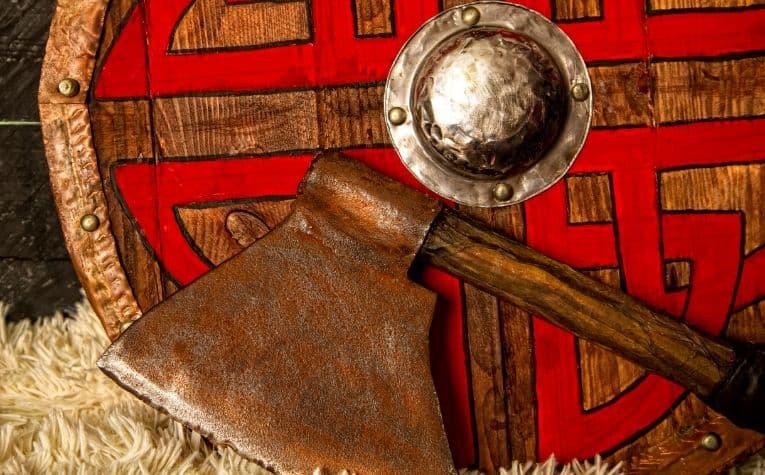From the end of the 8th century through the middle of the 11th century, the Vikings were a dominant force in Northern Europe.
Through their raids and military campaigns, they conquered new lands and eventually settled in many of them.
Much of their success can be attributed to their hardened Norse mindset, fierce fighting style, elite combat skills, and their distinct weaponry.
Axes were the weapon of choice for the common Viking warrior who could not afford to carry a sword into battle.
The axes used for combat were light enough to swing with one hand but still capable of delivering a mortal wound.
Viking axes were also instrumental in building the famed Viking longboats.
Were it not for the humble axe, the Vikings’ fighting style would have been much different, and quite possibly, their battles would have ended with less favorable results.
With a single blow, a Viking axe could dismember armored limbs and crack shields and helmets in two.
Battles were half won by the mere sight of a battalion of fearless Viking warriors advancing forward with their battle axes raised.
Besides an axe, a shield was critically important in Viking combat. See The Viking shield: Why is it round, wooden and painted? to learn more.
Why are Vikings so Closely Associated with Axes?

The biggest reasons that Vikings are so closely associated with axes are that these implements were practical, functional, and, perhaps most importantly, affordable.
During the Middle Ages, certain materials were either very scarce or very expensive. Such was the case with metals like iron and steel, from which the business end of swords and axes were typically made.
While the mighty double-edged sword is considered to be the poster child for Viking military might, the reality is that very few Viking warriors actually owned one.
During the Viking Age, swords were very expensive to make, so only the wealthy and powerful fought with them.
Swords were so valuable that they were passed down from generation to generation or buried with chieftains as grave goods. [1]
In contrast, every free Viking male owned an axe, whether it was a modest wood-chopping tool that doubled as a weapon during raiding season or a specialized weapon designed specifically for combat situations.
Did Vikings have permanent markings on their skin? See How Vikings got tattoos (and why) to learn more.
Viking men often began using their first axe as young boys.
With heads made from iron or steel, axes required the use of far less metal than swords, with a fraction of the amount of labor required to fabricate them.
Even Norse upper classes recognized the utility of axes, arming themselves with two-handed versions that were just as effective as swords and even decorating the heads of their axes with ornate designs. (Also see What Weapons Did the Vikings Use? The Top 5)
So highly regarded were axes as armament that royal poets wrote of Scandinavian kings splitting heads like firewood with them. Even today, Norway’s Royal Coat of Arms prominently features a battle axe. [2]
What Axes did the Vikings use as Weapons?

The association between Vikings and their battle-axes grew in prominence as news of their brutal exploits and military acumen spread throughout Northern Europe.
As with many implements of war, the axe underwent refinements and modifications as time went on to enhance its lethality and functionality on the battlefield.
Contrary to popular belief, the typical Viking battle axe was not a heavy, clunky object that required the likes of Thor to wield it properly.
Viking warriors preferred their axes to be light (most would have weighed between 2 to 5 pounds) to make them more agile.
In this way, the battle-ax could be an extension of their hands and arms and swung freely.
What else was part of the Vikings’ combat equipment? See Did Vikings Wear Chainmail? to learn more.
It is also important to note that Viking axes were not used exclusively for swinging at enemy forces either. They were Middle Age multi-taskers that performed a variety of functions like:
- The unique curvature of the blade and edge allowed Viking warriors to use their axes to grasp at weapons and shields or even the enemy’s appendages, to knock them off-balance or drag them to the ground
- Viking axes were even used to scale walls of structures (like enemy forts) much in the way that a mountain climber would use a pick [3]
Although the Vikings used axes of various shapes and sizes in battle, two designs were noteworthy during the height of the Viking Age for being highly wieldable and especially lethal:
- Dane Axe – also known as a Danish axe or hafted axe, this was the quintessential Viking battle-axe, with its signature long cutting edge (typically measuring 8 to 12 inches) and blade that narrowed at the haft, which itself varied from 3 to 4 feet in length. Elite Viking warriors were armed with Dane axes with hardened steel welded to the blade for even sharper edges.
This weapon was so instrumental to Viking military campaigns that the personal bodyguards of King Harold II were armed with them. (Also see The Viking Shield: The Meaning of Their Shape, Color, and Patterns)
Eventually, opposing armies saw this weapon’s advantages and began arming themselves with similar armaments (the Dane axe also came to be known as the English long axe).
The Dane axe was designed to be wielded with two hands, and its head was forged from thin but strong metal, resulting in a surprisingly lightweight weapon that could be swung with a great amount of control.
Still, it could deliver a fatal wound with a single blow from its razor-sharp edge. [4] [5]
- Bearded Axe – believed to have originated somewhere in Scandinavia around 600 BC, the bearded axe (also known as the skeggox) featured a distinct blade design that proved to be advantageous in several ways.
First and foremost, with its elongated edge that dropped down well below the butt or poll, a bearded axe presented a longer cutting edge as measured from toe to heel.
It could slice, slash, and chop with deadly force in the hands of a capable Viking warrior (it could also be wielded single-handed).
Grasping the axe’s haft behind the beard also protected the wielder’s hand.
The unique beard design also served a defensive purpose. By hooking an enemy’s weapon behind the beard, a Viking warrior could quick disarm and strike him down, and in a similar fashion, could pry a shield out of a combatant’s hand. [6]
Axes Played a Crucial Role During the Viking Age

As the most affordable and functional implement around, virtually every Viking male (except for slaves) owned an axe.
Aside from being a highly effective weapon for the Viking style of combat, axes served other purposes that were equally vital to the Viking way of life:
- Farming and performing chores – contrary to popular belief, most Norse people during the Viking Age did not participate in raids. Rather, they were simple, hardworking farmers, hunters, and craftsmen, who relied on their hands, the sweat of their brow, and the earth’s bounty for sustenance and subsistence.
Therefore, a good, sharp axe was a necessity of life for daily activities like felling trees and chopping wood for building materials and to burn as fuel for cooking and warmth.
Axes could also be used to clear land for farming or for raising livestock. As any experienced outdoorsman can attest, a good, sharp axe makes living a rugged lifestyle much easier. [7]
- Building ships – one of the Viking Age’s crowning achievements was the perfection of the iconic Viking longboat. Considered by many scholars to be a naval engineering marvel, this distinctive vessel enabled Norse warriors to navigate shallow waters and strike unsuspecting targets with unimaginable speed.
Incredibly, each Viking longboat was built entirely by hand and without the use of saws.
Native trees like oak and pine were split along the grain with axes and wedges to create wooden planks that were joined in an overlapping fashion to produce the signature clinker design that gave Viking vessels their unique strength and flexibility. [8]
Final Thoughts
Whether it was used for splitting logs or striking down enemy forces, the axe was an instrumental part of Norse expansion during the Viking Age.
References:
[1] medievalchronicles.com
[2] norse-mythology.org
[3] historyofvikings.com
[4] ancient-origins.net
[5] albion-swords.com
[6] viking-styles.com
[7] en.natmus.dk
[8] regia.org
